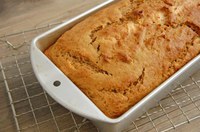Prairie Fare: Could Your Cellphone or Tablet Be a Germ Catcher?
(Click an image below to view a high-resolution image that can be downloaded)
By Julie Garden-Robinson, Food and Nutrition Specialist
NDSU Extension
“I found the perfect gift for you,” my husband grinned and said a few years ago.
What did he find? I thought to myself. I awaited gift opening with anticipation.
When I opened the neatly wrapped package, at first I couldn’t figure out what it was. It was made of wood and folded flat in a box.
“Oh, it’s a photo easel,” I said kind of feebly. “Well, that’s nice.”
He looked a little disappointed in my reaction.
“I bought it at a kitchen store,” he added.
He was holding my tablet computer and he set it on the wooden stand. Then he swapped a cookbook for the tablet.
Yes, this was a nifty gift that I use regularly to protect my cookbooks and tablet from recipe ingredients.
Smartphones, tablets and other gadgets are used widely. Have you noticed anyone perusing recipes in the kitchen when making dinner? Have you seen people texting while eating?
Perhaps you’ve used the screens at restaurants that allow you to dispense soda, play games or order food. You also may have noticed people texting while waiting in lines in public restrooms.
Think about it: Not everyone washes their hands the recommended 20 seconds. We all use the same door handles in public restrooms.
Unfortunately, phones and other electronic gadgets can be “germ catchers.” According to research conducted at the University of Arizona, cellphones may carry 10 times the amount of bacteria as found on toilet seats
Several researchers have explored the cleanliness of phones and other devices. In a 2017 study reported in the journal Germs, researchers performed microbiological testing on 27 phones used by students. The researchers noted bacteria, including potential disease-causing organisms such as staph. Males and females had contaminated phones.
The researchers also noted the presence of E. faecalis. Yes, that sounds like feces for a reason. This type of bacteria is associated with the human gastrointestinal tract. Its presence probably indicates failure to wash hands properly after using the restroom and before using a phone.
Cellphones can spread bacteria and viruses. Wiping down the screens you use in your kitchen or during eating can help safeguard your health, as can proper hand-washing. You obviously can’t dunk your phone or other device in a sanitizer because you could damage your phone seriously.
To clean your phone, many references suggest filling a small spray bottle with a 50/50 mixture of distilled water and rubbing alcohol (70 percent isopropyl alcohol). Unplug and/or turn off the phone first. Spritz with the mixture, then wipe with a microfiber cloth to avoid scratching the screen.
However, consult your manufacturer’s guide to see if this is an acceptable approach for your phone or other device.
In recognition of the upcoming holiday season, this week I have a couple of things for you: a printable calendar and some make-it-yourself food gift mix ideas. See https://www.ag.ndsu.edu/fieldtofork to view the calendar and its recipes. See https://www.ag.ndsu.edu/food for several food mixes, along with printable gift tags.
This is one of the featured recipes. To complete a gift basket, consider making some jam, too. We also have jam recipes on our website.
Peanut Butter Bread
1/3 c. sugar
1/3 c. brown sugar, packed
1 1/4 c. all-purpose white flour
3/4 c. whole-wheat flour
1 Tbsp. baking powder
1/4 tsp. salt
Layer ingredients in a clean quart-sized jar. Cover the jar tightly with a lid, decorate and attach a copy of the recipe card.
To make bread, mix together:
1 container Peanut Butter Bread mix
1 c. creamy peanut butter (not natural)
2 eggs
3/4 c. nonfat milk
1/2 c. plain Greek yogurt, nonfat
1 tsp. vanilla
Preheat oven to 350 degrees. Spray a 9- by 5-inch loaf pan with nonstick cooking spray. In a mixing bowl, combine the sugar, brown sugar, white and whole-wheat flour, baking powder and salt. Set aside. In a separate bowl, combine peanut butter, eggs, milk, Greek yogurt and vanilla. Gradually add dry ingredients to wet ingredients, gently folding ingredients together. Mix just until combined; the batter may be lumpy. Pour into the loaf pan and bake for 48 to 52 minutes. Check bread 10 to 15 minutes before the timer goes off, and if the bread is browning too much, place aluminum foil on top and continue baking for duration of time. Allow bread to cool for 10 minutes, remove from pan and place on cooling rack.
Makes 16 servings. Each serving contains 200 calories, 9 grams (g) fat, 7 g protein, 25 g carbohydrate, 1 g fiber and 210 milligrams sodium.
(Julie Garden-Robinson, Ph.D., R.D., L.R.D., is a North Dakota State University Extension food and nutrition specialist and professor in the Department of Health, Nutrition and Exercise Sciences. Follow her on Twitter @jgardenrobinson)
NDSU Agriculture Communication - Dec. 13, 2018
| Source: | Julie Garden-Robinson, 701-231-7187, julie.garden-robinson@ndsu.edu |
|---|---|
| Editor: | Ellen Crawford, 701-231-5391, ellen.crawford@ndsu.edu |



